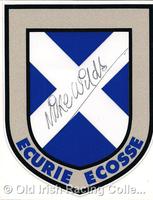Ecurie Ecosse (team Scotland) was started in 1951 as a partnership between racing driver David Murray and mechanic Wilkie Wilkinson who started racing a Cooper in Formula One and later moved on to racing sports cars. They were the pride of Scotland, especially with their crowning achievement of winning Le Mans for Jaguar in 1956 and 1957. They continued to race a variety of cars in ther traditional flag blue with a white nose stripe, but without the same success. Wilkinson eventually moved on to BRM and the original team stopped racing in 1962. In its first revival, Ecurie Ecosse team entered cars in Formula Two from 1969-1971 and in 1971 employed a new driver named Tom Walkinshaw. The team had little success. Scottish racing enthusiast Hugh McCaig, along with friend Graham Gould revived the team a second time in the 1980's, winning the World Sportscar Championship for Class C2 in 1986. The team partnered with Aston Martin in 1989 to again contest Le Mans, before moving on to the British Touring Car Championship. McCaig's team began racing again in 2011 with an Aston Martin DBR9S, 25-years after the World Sportscar Championship in 1986. In a departure from British cars, the team has been running a BMW in GT3 races in Europe and plans to contest that class at Le Mans in 2014.

THE SIGNATURE PROJECT & RACING DIORAMAS
World F1 Champions 1950 - PRESENT
GREAT AUTOMOTIVE MAKES & RACING TEAMS:
AMERICAN:
CHAPARRAL
CHEVROLET & GM POWERED RACE CARS
COBRAS & DAYTONAS - SHELBY CARS
CUNNINGHAM EQUIPE - THE CARS OF BRIGGS CUNNINGHAM
FORD POWER: GT40's, MUSTANGS & MORE
MISC. AMERICAN MADE
BRITISH:
ASTON MARTIN RACE & PRODUCTION
AUSTIN HEALEY & HEALEY
BRABHAM F1 & SPORTS CARS
BRM F1 & SPORTS CARS
LOLA SPORTS RACING CARS
LOTUS F1, RACE & PRODUCTION
McLAREN RACING & PRODUCTION CARS
MG CARS - RACING & PRODUCTION
TRIUMPH RACE & PRODUCTION CARS
MISC. BRITISH MADE
FRENCH:
BUGATTI
FRENCH MADE
GERMAN & SWEDISH:
AUDI RACING
BMW RACE & PRODUCTION
MERCEDES BENZ RACE & PRODUCTION
MISC. GERMAN & SWEDISH MADE
ITALIAN & SPANISH:
ABARTH RACING
ALFA ROMEO RACE & PRODUCTION
LANCIA RACE & PRODUCTION
MASERATI RACE & PRODUCTION
MISC. ITALIAN & SPANISH MADE
JAPANESE:
DATSUN/NISSAN RACING
TOYOTA RACE & PRODUCTION CARS
MISC. JAPAN, ASIAN & AUSTRALIAN MADE
VETERAN, CLASSIC & SPECIAL INTEREST CARS All MARQUES
LAND SPEED AND ENDURANCE RECORD CARS THE TRIPLE CROWN OF ENDURANCE RACES: DRIVER TRIBUTES: PLAY BALL! - IT'S BASEBALL TIME:
For copies of images, questions or comments about the collection to: OLD IRISH RACING
Back to: OLD IRISH RACING MODELS INDEX Home Page
Back to: OLD IRISH RACING Home Page Legal stuff: Content and images on this website unless stated, are the property and content of Old Irish Racing and may not be used without permission. Old Irish Racing is not affiliated with, or represent any other entity past or present.
PLEASE NOTE: From 1968 into the 1990's tobacco companies sponsored many significant race cars. We don't promote tobacco use, rather we stronly discourage it. However, we do promote historical accuracy, Old Irish Racing chooses
to display models in our collection as historically accurate as possible. While seeing a tobacco advert on a car gives me no more desire to go smoke than seeing a car makes me want to go
suck on its exhaust pipe. If tobacco (or alcohol) adverts on race cars offend you, please go look at nice pictures of bunnies and kittens on another site. Thank you!
THE 24 HOURS of LE MANS 100 YEARS - 1923-2023
THE 12 Hours of SEBRING WINNERS
THE 24 HOURS of DAYTONA WINNERS
THE OLD IRISH RACING HALL OF FAME
JUAN MANUEL FANGIO TRIBUTE
STIRLING MOSS TRIBUTE
WORLD DRIVER & CONSTRUCTORS CHAMPIONS 1950 - 1985
A TRIBUTE TO BOYHOOD HEROES AND MY DAD
All pages and content on this website (unless noted) are owned and the copyrighted and may not be reproduced or redistributed without the consent of Old Irish Racing. This is a private collection, unless noted, pieces are not for sale!